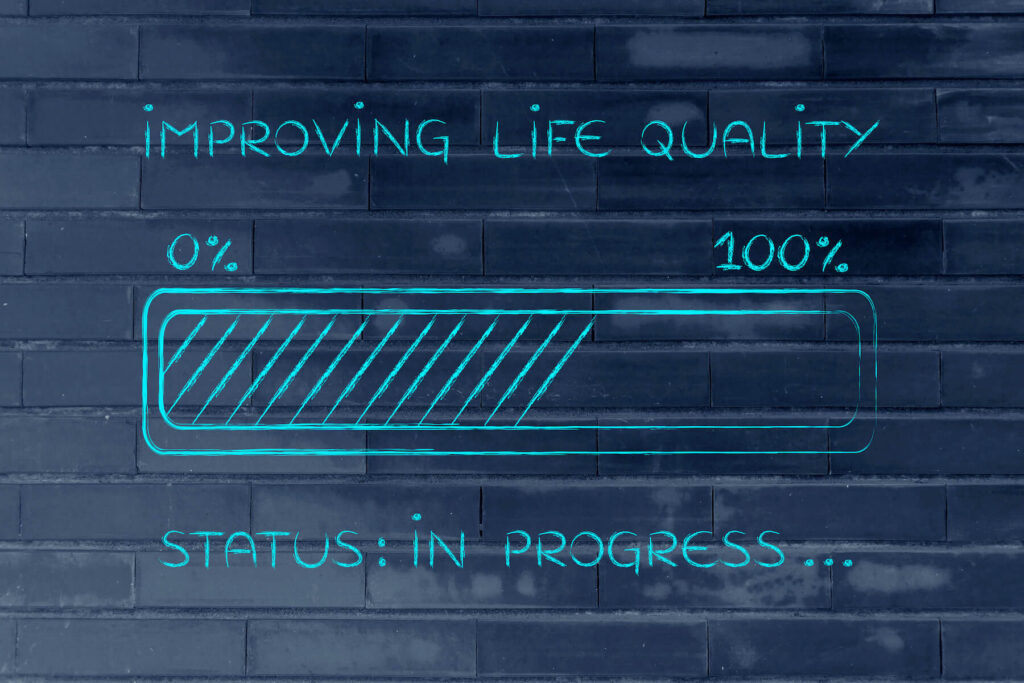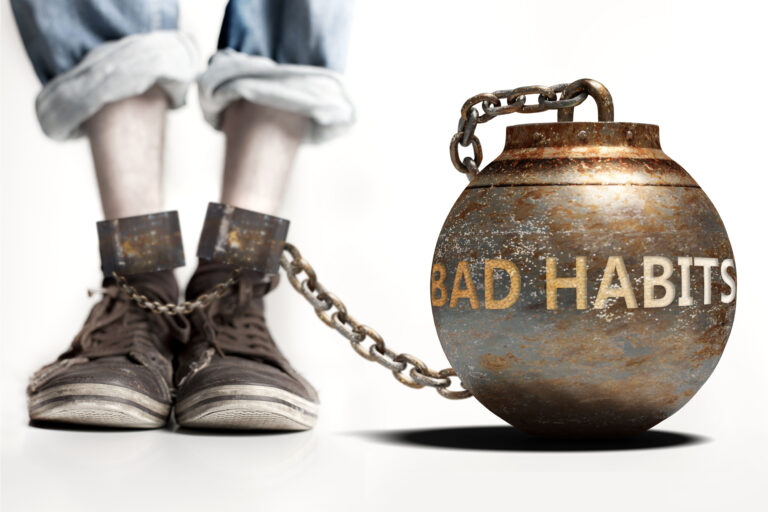Got bad habits? You probably do. And you’re not alone.
Are you in the habit of avoiding hard or uncomfortable things, or people? Dispensing advice without being asked?
Not getting enough fresh air and sunshine? Not exercising and moving enough? Sitting too much? Procrastinating? Being late or doing things at the last minute?
Blaming others instead of taking responsibility and finding solutions? Complaining? Doubting yourself? Compulsively using your smartphone?
Okay, so you have some bad habits.
Unfortunately, those bad habits can add up to big problems over time: unhappiness, poor health, feeling stuck, lower performance, and relationship harm.
In dealing with bad habits, it’s not as simple as summoning your willpower so you can be stronger when faced with temptation or maladaptive routines. You need more sustainable strategies since your willpower can erode over time.
How to Break Bad Habits and Create Good Ones
Thankfully, there are many ways to break bad habits and create good ones. Here are 15 practical approaches:
1. Begin by believing you can change your habits.
Also, believe that if you do so, you’re likely to see powerful results. It all starts with mindset.
2. Study your bad habits.
Develop self-awareness and get clear on the patterns of your bad habits: What triggers them? How and when? Where? With whom? How often?
3. Determine the underlying drivers of your bad habits and address those deeper issues.
If stress is prompting one or more bad habits, deal directly with the person or issue that’s causing the stress. That will eliminate the need for a habitual coping mechanism.
4. Focus on “keystone habits,” since they affect several areas of your life.
In The Power of Habit, Charles Duhigg wrote about “keystone habits” that can cause widespread shifts in other areas. For example, he cites the following research about leading keystone habits: A habit of regular exercise often leads people to eat better, become more productive at work, show more patience with others, report feeling less stressed, use credit cards less, and smoke less. The habit of eating together as a family is associated with children having more confidence and emotional control, as well as better homework skills and grades. And the habit of making our beds each morning is associated with higher productivity and a greater sense of well-being and financial discipline.
5. Prime your environment to promote good habits and prevent bad ones.
Set out your workout clothes and gear the night before so you’re ready to exercise in the morning. Or prepare healthy meals on weekends so they’re ready for the week ahead. Place your smartphone in a different room when you need to focus so you’re not tempted by notifications.
“Environment is the invisible hand that shapes human behavior….
Create an environment where doing the right thing is as easy as possible.”
-James Clear, writer and speaker

Take the Traps Test
We all fall into traps in life. Sometimes we’re not even aware of it, and we can’t get out of traps we don’t know we’re in. Evaluate yourself with our Traps Test.
6. Develop systems that promote good habits instead of simply setting goals and trying to reach them.
Automate things you do over and over. Set up processes that help you eliminate non-essential tasks and avoid repetition. Use your calendar to ensure you’re focusing on the right things at the right time.
“If you want better results, then forget about setting goals. Focus on your system instead….
You do not rise to the level of your goals. You fall to the level of your systems.”
-James Clear
7. Follow the four laws of behavior change:
- Make it obvious. Use a visual cue that tees up the intended behavior. Example: Leave out the materials you need for your workout drink. It will remind you to get your workout in.
- Make it attractive. Give yourself a reward—ideally something you crave—after you do the desired habit. Example: Watch your favorite show only if you reach your daily quota on completing your critical project.
- Make it easy. If your phone is in another room while you’re doing deep work, it won’t be difficult to fight the temptation to scroll.
- Make it satisfying. Use a checklist and enjoy noting your progress as you go when you’ve had the discipline to do your important work for the day. (Source: James Clear, Atomic Habits)
8. Focus on who you wish to become through your good habits and systems, not on what you want to achieve.
There’s something powerful about this one. If you become the kind of person who exercises every day, or who eats healthy food, it starts to become engrained and automatic. You don’t have to keep fighting for it. You live into it.
“Your identity emerges out of your habits. Every action is a vote for the type of person you wish to become.”
-James Clear
9. Focus on replacing bad habits with good habits instead of breaking your bad habits.
For me, replacing a hazy morning of checking the news or email with an intentional morning of reading, meditation, and prayer has been a gamechanger. A simple replacement can go a long way.
https://greggvanourek.com/why-we-need-meditation/
10. Eliminate the triggers that your brain associates with the bad habit.
Move the remote control away from the TV. Turn off your notifications. Don’t keep junk snacks in the pantry.

Quality of Life Assessment
Evaluate your quality of life in ten key areas by taking our assessment. Discover your strongest areas, and the areas that need work, then act accordingly.
11. Leverage technology to help automate your habits.
Build good habits into your calendar and set reminders for them.
12. Find an accountability partner to help you with habits.
Make joint commitments. Check in regularly to hold each other accountable. Celebrate progress and victories together.
13. Surround yourself with people who live the way you want.
One powerful reason this works is that you don’t want to be the one who lets others down or doesn’t follow through with commitments. Also, surround yourself with visual cues of what you want—like Post-It notes, screen savers, pictures, refrigerator decorations, or vision boards with a message or images of your desired future.
14. Turn a good habit into a streak that you track and celebrate.
Track progress and celebrate success so you feel and enjoy a sense of progress and momentum. Sometimes gamification or challenges can be real motivators (motivation to succeed and/or avoid failure).
15. Anticipate setbacks.
Don’t expect perfection in all habit-busting domains. When there’s a letdown, commit to getting back on track right away. Don’t let the bad habit groove re-establish itself.

Goal-Setting Template
Goals are the desired results we hope to achieve—the object of our effort and ambition. Goals are common in our life and work, but that doesn’t mean we’re good at setting and achieving them. Use this Goal-Setting Template to set your goals properly, based on the research and best practice.
Final Thoughts
By replacing your bad habits with good ones, designing your environment to be more conducive to the life you want, and developing systems that help you be your best, you can improve your life dramatically.
Good habits create leverage. More progress, with less struggle and effort. Stop shooting yourself in the foot and start elevating your days, one habit at a time.
Reflection Questions
- What are your worst habits?
- How are they affecting you?
- What will you do about them, starting today?
Tools for You
- Traps Test (Common Traps of Living) to help you identify what’s getting in the way of your happiness and quality of life
- Quality of Life Assessment to help you discover your strongest areas and the areas that need work and then act accordingly
- Personal Values Exercise to help you clarify what’s most important to you

Personal Values Exercise
Complete this exercise to identify your personal values. It will help you develop self-awareness, including clarity about what’s most important to you in life and work, and serve as a safe harbor for you to return to when things are tough.
Related Articles
- “How to Stop Blaming Others: 10 Tips“
- “The Trap of a Victim Mentality–And What to Do About It“
- “The Trap of Bad Habits–And How to Break Them“
- “Getting to the Root Causes of Things: Why and How”
- “The Power of Taking Full Responsibility for Your Life“
Postscript: Inspirations on Habits
- “Drop by drop is the water pot filled.” -Siddhartha Gautama (the Buddha)
- “First forget inspiration. Habit is more dependable. Habit will sustain you whether you’re inspired or not.” -Octavia Butler, science fiction writer
- “The secret to getting results that last is to never stop making improvements…. Small habits don’t add up. They compound. That’s the power of atomic habits. Tiny changes. Remarkable results.” -James Clear, writer and speaker
- “If you are going to achieve excellence in big things, you develop the habit in little matters.” -Colin Powell, U.S. Army officer, statesman, and diplomat
- “Good habits are worth being fanatical about.” -John Irving, writer
- “In essence, if we want to direct our lives, we must take control of our consistent actions. It’s not what we do once in a while that shapes our lives, but what we do consistently.” -Tony Robbins, author, entrepreneur, and philanthropist
- “Success is the product of daily habits—not once-in-a-lifetime transformations.” -James Clear
- “Successful people are simply those with successful habits.” -Brian Tracy, Canadian-American author and speaker

Gregg Vanourek’s Newsletter
Join our rapidly growing community. Sign up now and get monthly inspirations (new articles, opportunities, and resources). Welcome!
+++++++++++++++++
Gregg Vanourek is a writer, teacher, and TEDx speaker on personal development and leadership. He is co-author of three books, including LIFE Entrepreneurs: Ordinary People Creating Extraordinary Lives (a manifesto for living with purpose and passion) and Triple Crown Leadership: Building Excellent, Ethical, and Enduring Organizations (a winner of the International Book Awards). Check out his Best Articles or get his monthly newsletter. If you found value in this article, please forward it to a friend. Every little bit helps!


1 thought on “How to Break Bad Habits and Create Good Ones”
Gregg Vanourek’s article, “How to Break Bad Habits and Create Good Ones,” offers a practical and insightful approach to habit transformation. He emphasizes the importance of mindset, self-awareness, and environmental design in overcoming detrimental habits. By focusing on replacing bad habits with positive ones and addressing underlying triggers, Vanourek provides readers with actionable strategies to foster lasting change. His emphasis on identity and systems over mere willpower offers a refreshing perspective on personal development.